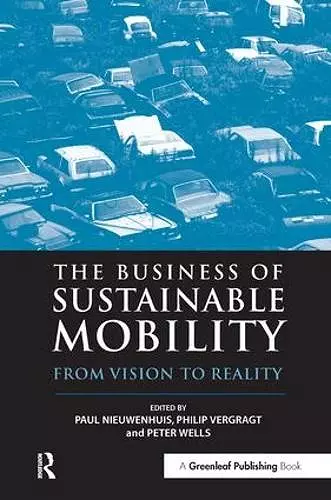The Business of Sustainable Mobility
From Vision to Reality
Peter Wells editor Paul Nieuwenhuis editor Philip Vergragt editor
Format:Hardback
Publisher:Taylor & Francis Ltd
Published:1st Jun '06
Should be back in stock very soon

Mobility is in crisis, but few seem aware of the full extent of it. This book shows that technology may well not be enough in itself and that for a genuinely sustainable transport future far more radical change affecting many aspects of society is needed.
In many parts of the world, there is a crisis of mobility. This book shows that technology may well not be enough in itself and that for a genuinely sustainable transport future far more radical change - affecting many aspects of society - is needed. It is useful for academics, practitioners, and policy-makers.
In many parts of the world, there is a crisis of mobility. The choices we have made over the past 200 years on modes and technologies of transport have brought us unprecedented global interaction and in many respects increased personal freedom. However, all this mobility has come at a cost to society, to the economy and to the environment. Mobility is in crisis, but few seem aware of the full extent of it. Though most people will be aware of congestion, accidents (although this aspect is often overlooked), parking restrictions or fuel prices, few will have considered the effects of the dramatic increase in mobility expected in China, India and elsewhere. Nor do many people in their daily lives consider the impact of climate change on our environment and the contribution our cars make to it. It is often thought that technology alone can solve this problem. For some observers, salvation could be achieved by means of hydrogen fuel cells, by hybrid cars, or by increased fuel efficiency, or even by telematics to reduce congestion. This book shows that "technology" may well not be enough in itself and that for a genuinely sustainable transport future far more radical change – affecting many aspects of society – is needed. It is likely, for example, that new business models are needed, as well as users and consumers adopting new forms of behaviour. Disruptive technological innovation may well contribute, but needs to be induced by a combination of market forces and government regulation.
Many studies touch on transport and mobility issues and more mainstream books aimed at challenging the dominance of automobility are common, yet works dealing with the longer-term strategic, theoretical and broader conceptual issues needed to inform the move towards more sustainable transport are rare. Yet policy-makers, practitioners, as well as many sections of academia, acknowledge a need for guidance on new thinking on sustainable mobility. This book brings together a range of views...
This book evolved from the Sustainable Mobility stream at the 2003 International Greening of Industry Network Conference in San Francisco. Predicated on a current near global crisis of mobility, the text focuses on the private car, which "we have built our world around" and whose benefits have "come at a high cost". The various authors hope to lead us towards a solution to the car's problems: "how to power it; how to build it; and how to deliver it in a more sustainable way", whilst acknowledging that "few cultural artefacts of the modern era reflect the dilemma of sustainability as well as the car." One solution is explored in some depth: the development of zero emission and resource-efficient hydrogen fuel cells. This would constitute a radical shift away from the internal combustion engine (ICE) paradigm and would require some urgent and major changes in behaviour. Chapters 1 to 5 introduce the technological, environmental, social and governmental contexts and bring the reader up to speed on the salient contemporary issues of hydrogen technology, battery powered vehicles, hybrid electric cars and the necessary institutionalization of fuel cells. Chapters 6 and 7 explore new supporting sustainable business and industrial models; acknowledging that much more than just technological change is required. Chapters 8 to 10 look at potential alternative vehicle types and concepts. Chapters 11 to 15 examine current trends and case studies in greening mobility from the US, South Africa and India and give a more near-term perspective on how the transition to a hydrogen economy might be progressed. Finally, Chapters 16 to 18 offer some visionary thinking (including some radical vehicle design concepts) and drawing together strands from the conference asserts that the necessary major technological innovations required will "almost certainly, come from Asia" (possibly China). This is a welcome, holistic treatment of the kinds of institutionalized, economic and cultural changes required to nurture and support technological innovation. This inclusive approach is reflected in a genuinely global outlook, a spread of international case studies, due importance given to the fast emerging players such as China and India, plus welcome local and community-based focus for framing supposedly sustainable solutions. The editors have tried to avoid some of the pitfalls of over-optimism in the main thrust of this work, but it would have been interesting to have heard more on the traps likely to be set by some of the darker forces of capitalism, politics and human nature, which will, I suspect inevitably, make the journey towards "sustainable mobility" more arduous still. -- Andy Ayres * Social and Environmental Accounting *
ISBN: 9781874719809
Dimensions: unknown
Weight: 530g
256 pages